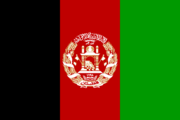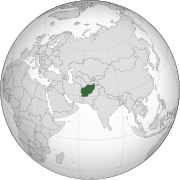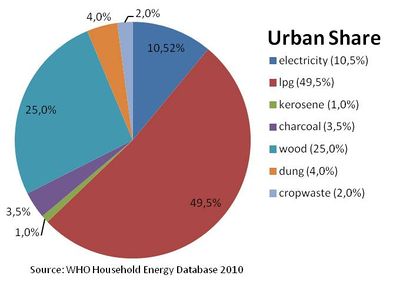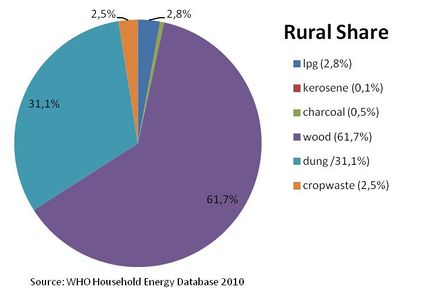Click here to register!
Difference between revisions of "Afghanistan Energy Situation"
From energypedia
***** (***** | *****) m |
***** (***** | *****) m |
||
| Line 74: | Line 74: | ||
= Overview = | = Overview = | ||
| − | = Geography and Climatic Conditions<br/> = | + | == Geography and Climatic Conditions<br/> == |
*Arid to semiarid; cold winters and hot summers | *Arid to semiarid; cold winters and hot summers | ||
| Line 94: | Line 94: | ||
<br/> | <br/> | ||
| − | = | + | = Energy Source = |
| − | |||
| − | |||
| − | |||
| − | |||
| − | |||
| − | |||
*Hydropower 63,7% | *Hydropower 63,7% | ||
| Line 106: | Line 100: | ||
<br/> | <br/> | ||
| − | |||
| − | |||
== Energy Consumption == | == Energy Consumption == | ||
| − | |||
| − | |||
| − | |||
| − | |||
| − | |||
| − | |||
==== Share of Fuel Types ==== | ==== Share of Fuel Types ==== | ||
| − | Percentage of energy types used for cooking in | + | Percentage of energy types used for cooking in urban areas <ref name="WHO 2010">WHO 2010: WHO Household Energy Database</ref> |
<br/> | <br/> | ||
| Line 131: | Line 117: | ||
<br/> | <br/> | ||
| − | ==== | + | ==== Solid Fuels ==== |
| + | |||
| + | Percentage of people using solid fuels<br/> | ||
National: >95% <ref>WHO (2006): Fuels for Life</ref> | National: >95% <ref>WHO (2006): Fuels for Life</ref> | ||
| Line 143: | Line 131: | ||
<br/> | <br/> | ||
| − | == | + | == Electricity Situation == |
| − | |||
| − | |||
Electrification rate in households:<ref>The National Risk and Vulnerability Assessment 2005, Kabul, Afghanistan. Cited in WHO (2009) The Energy Access Situation in developing Countries</ref> | Electrification rate in households:<ref>The National Risk and Vulnerability Assessment 2005, Kabul, Afghanistan. Cited in WHO (2009) The Energy Access Situation in developing Countries</ref> | ||
| Line 154: | Line 140: | ||
<br/> | <br/> | ||
| − | = Policy Framework, Laws and Regulations | + | = Policy Framework, Laws and Regulations = |
| − | |||
| − | |||
| − | |||
| − | |||
= Further Information = | = Further Information = | ||
| Line 166: | Line 148: | ||
<references /> | <references /> | ||
| + | [[Category:Country_Energy_Situation]] | ||
[[Category:Afghanistan]] | [[Category:Afghanistan]] | ||
| − | |||
Revision as of 08:37, 2 April 2014
| Afghanistan | |||
|---|---|---|---|
| Capital | Kabul (34° 32′ 0″ N, 69° 10′ 0″ E) | ||
| Official Languages(s) | Dari (Persian) and Pashto | ||
| Government | Islamic republic | ||
| President | Hamid Karzai | ||
| Total Area | 647,500 km² | ||
| Population | 29.8 million | ||
| Rural Population | 23 million (77%) | ||
| Urban Population | 6.8 million (23%) | ||
| Population Density | 43 Persons per km² | ||
| GDP (Nominal) | $15.608 billion | ||
| GDP Per Capita | $517 | ||
| Currency | Afghani (AFN) | ||
| Time Zone | CET (UTC+04:30) | ||
| Electricity Generation | TWh/year (year) | ||
| Calling Code | +93 | ||
| Access to Electricity | % | ||
| Wind energy (installed capacity) | MW (year) | ||
| Solar Energy (installed capacity) | MW (year) | ||
Overview
Geography and Climatic Conditions
- Arid to semiarid; cold winters and hot summers
- Mean temperature (°C min/max): 4.3/19.6 [1]
- Natural gas, petroleum, coal [2]
- Land area covered by forest: 1.3%
- Forest annual rate of change: 0% [3]
Socioeconomical Situation
Income Sources
- Agriculture: 79%
- Industry: 6%
- Services: 16%
Energy Source
- Hydropower 63,7%
- fossil fuels 35,3%
Energy Consumption
Percentage of energy types used for cooking in urban areas [4]
Percentage of energy types used for cooking in rural areas. [4]
Solid Fuels
Percentage of people using solid fuels
National: >95% [5]
Solid Fuel Use Impact on Health
Total annual deaths attributable to solid fuel use: 23900 persons
Percentage of national burden of diseases attributable to solid fuel use: 4.9% [6]
Electricity Situation
Electrification rate in households:[7]
- National: 23%
- Urban: 74%
- Rural: 3%
Policy Framework, Laws and Regulations
Further Information
References
- ↑ UN Data (2008): http://data.un.org/CountryProfile.aspx?crName=Afghanistan
- ↑ CIA - The World Factbook: https://www.cia.gov/library/publications/the-world-factbook/geos/af.html
- ↑ FAO (2011) The State of the World's Forest
- ↑ 4.0 4.1 WHO 2010: WHO Household Energy Database
- ↑ WHO (2006): Fuels for Life
- ↑ WHO (2006): Fuels for Life
- ↑ The National Risk and Vulnerability Assessment 2005, Kabul, Afghanistan. Cited in WHO (2009) The Energy Access Situation in developing Countries























